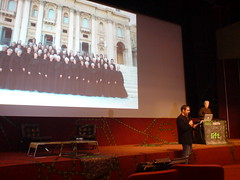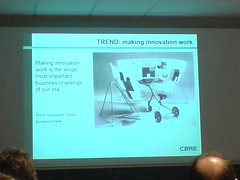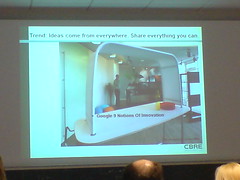LIFT07: Going virtual in proportion to being actual, Sister Judith Zoebelein
February 08, 2007 | Comments LIFT07: Going virtual in proportion to being actual, Sister Judith Zoebelein
LIFT07: Going virtual in proportion to being actual, Sister Judith Zoebelein
Franciscan sister of the Eucharist. Tries to play some video but it doesn't work. I bite off my tongue. She's a mac user :)
The power of the internet relies in a great part on symbol and subliminal effect.
Internet permits us into a global reality. What I have to say applies to a certain setting, but I think it also applies globally.
Opened a single-page Vatican site Christmas 1995. The church has been a network around the world for centuries. The idea of a local parish centring people through worship and outreach is fading in North America and Europe. Sometimes when I'm using Skype and see how many others are there, I feel part of a community. And at the same time threatened by "rangerdude", who keeps trying to call me.
In SimCity, I can go online and become what I dreamed of: a professional baseball player (I think she means The Sims).
Any community should give a greater sense of personhood.
Talks about an e-learning course they ran, on suffering. But the group for this course meets face-to-face. "The anonymity of the internet must lead to the desire for an actual human encounter". It's a basic lesson of the church: "there must be a sacramentality to our lives". A supporting module lets viewers walk with Pope John Paul.
Q: The vatican site preaches. Why is it not more "web 2.0" (conversational)?
A: It was initially planned as an archive, and what's up there reflects that.
Q: Are you looking at other models like MySpace, SecondLife, etc?
A: Yes. We want to establish sub-groups for different areas of the world.
Aside: is anything more virtual than God?
LIFT07: Everyware, further down the rabbit hole, Adam Greenfield
February 08, 2007 | CommentsLIFT07: Everyware, further down the rabbit hole, Adam Greenfield
The terms for this stuff ("tangible media", etc.) are ugly, associated with funding sources, etc. He prefers term "Everyware".
Everyware: post-PC, information processing in objects and surfaces of everyday life. Mark Weiser of Xerox Parc: "invisible, but in the woodwork everywhere around us", and "the most profound technologies are those which disappear". (This is what I like about mobile)
Characteristics of Weisers ubicomp: embedded, wireless, imperceptible.
Information processing turns up in new places and takes on new tasks. e.g. iPhone (don't get this one), Nike iPod. People aren't thinking carefully about the ramifications.
Internet of things: "I can query a chair". These things can then talk to each other: personal biometric monitors, RFID transit passes, floor sensors, etc.
A class of systems that tends to colonise everyday life: leading to, e.g. Jeremy Bentham's panopticon. Everyware does something to surveillance: there are sensors of all sorts everywhere. e.g. the Internet toilet which reports details of your turds to (e.g.) your doctor. But it could go to Youtube! Surveillance is now a product not just of our willed actions, but of actions which we take without knowing it.
Things that were latent are brought to light (e.g. the enforced rating of your contacts as a friend, contact or family in Flickr: you have to choose!), just as things that were visible (machinery) are being made invisible.
This isn't science fiction. Ubiquity is latent in technical standards: IPv6 allows 6.5 x 10^23 addresses for every square metre on the earth's surface. By 2004, 95% of the Hong Kong population aged 16-65 were using RFID-based Octopus system. It's there now.
Designers of PC-era informatics don't worry about engaging their systems in the absence of an active decision to do so. With everyware, implicit actions can trigger activity. But people make mistakes: we press the wrong button, click the wrong link, etc. If I transmit my location information to everyone instead of just my friends... that's awful. Inadvertent unknown and unwilling use need to be addressed by designers: how can I choose to opt out of this infrastructure if I wish to - what are my rights? None of this stuff comes up with PC computing, but a serious concern for Everyware.
You can derive meaningful knowledge from inference by machines. But how I, as a participant, determine how these inferences were made or signal that they are invalid?
There are no longer any standalone products. Anything might talk to to anything. What can we do to accommodate unpredictable and undesired emergent behaviours?
Q: Is there a place for fake information, for masquerade in this world?
A: I don't see any way to avoid that. Metadata in the wild is rarely useful for long - look at P2P networks and the quality of information in them. People in MySpace list their age as 99,999 to be funny. We need a higher quality of interaction design to cope with this.
Q: Does investing physical space with a digital aura change the nature of that space?
A: Yes. The place where I first kissed my wife in Tokyo is meaningful. If I expose that it might have meaning. What about crime data - tagging locations where murders occur. Do you react differently to a space if you know there have been murders there? Of course.
links for 2007-02-07
February 07, 2007 | Comments-
Ribot's worlds collide.
LIFT07: Collaboration and Innovation in Workspace that Works
February 07, 2007 | CommentsLIFT07: Collaboration and Innovation in Workspace that Works - Clark Elliott
CE starts the session by getting us all to stand up and touch hands with 5 other people in the room.
"What's work in the 21st century? I think Dilbertville is dead. I'm a space planner, a workspace strategist. Studied social psychology. The french word "travail" comes from the Latin word for "torture". The word "labour" has connotations with pain. In the 21st century, this word has nothing to do with knowledge work - we're not doing physical labour."
CE shows coloured map of a network of communications within a real company - not an organogram, a real documentation of what's there.
 "So how might you organise office buildings?"
"So how might you organise office buildings?"
CE goes around the room asking attendees what they want out of the session. Most interesting ones I heard were a couple of Swedish industrial design students studying crowded spaces and queuing strategies - wow - and a Swiss guy who, in a strong French accent, talks about how he cannot concentrate at work because "my colleague, she eez so beautiful..." :)
CE: Themes there were collaboration, virtual collaboration, obstacles to change, relationships, enjoyable, interacting with human beings (even when somewhere else). It's all about the intersection between technology, people and space. Communicating properly over virtual methods (e.g. video-conferencing) is difficult.
CE: There's a lot of resistance to change: closed-office workers don't want open space. Senior managers see loss of offices as loss of status. Concentration and interruptions are a factor. On Lake Geneva is a beautiful building but useless office: many closed rooms. People send emails to someone 3 feet away. The phsyical space stops communication. At the UN you have issues of status (certain grades get the right to numbers of windows). But the goal of the business is to produce results.
(So far so good: people don't like change and you need communication in office spaces. Nothing particularly ground-breaking here)
CE: If you create modern office environments you should change everything. You don't get teamwork between a group of folks who are all compensated radically differently. Space-planning strategies need to understand the organisation. Cultures are driven by cost and quality control. Creative thinking is what this is about: we're knowledge workers.
(Wondering to myself what %age of the global working population are "knowledge workers". Definitely over-represented in the LIFT07 delegates ;))
CE: Trend: activity based design. Shows example of a large company with different "zones": printing area, confrence room, mobile workers, etc. 600 mobile staff, 600 fixed staff, lots of desk-sharing. 200 workplaces for the 600 workers, but lots of other areas to work on. There were no reservations for workplaces: first come first served. If you do desk-sharing there has to be enough space that no-one can't find somewhere and going home.
CE: Trend: 80% of meetings take less than 8 minutes. Shows slide: "when time spent reviewing a project with co-workers starts to feel more like good friends making plans and sharing stories, we'll know that effective workspaces have hit the mark". Talks about desk-sharing: you can theorise about it, people will get all sorts of "yeah but" reasons. Just try it, and give people the reason for doing it: not to save space or money, but to get people communicating better.
CE: People don't like moving furniture around.
Q: how do you stop people going to old habits, marking out their territory and keeping it?
CE: It happens. Over the years in Vienna we created a user guide, handbook and groundrules. You say "mobile desks are for everybody". The cleaners clean the desks completely - there's no paper kept around.
Q: But personalisation is everything?
CE: Every worker had their own storage area for filing, mobiles, etc. I didn't take away your desk, I gave you a bureau buffet. The whole floor is your office.
(I like bits about this, but confess to being cynical about it in its entirety for, say, a company like FP: though I can see the value in physically arranging project teams together)
Q: What about working from home?
CE: It brings up a series of issues. At DEC, Compaq, HP, and Cable & Wireless, we did not push home working. In the UK it's pushed to a high level because of commuting, traffic, and environmental impact of travel. In Geneva people don't have large houses, there's no space for it. What's the insurance impact of folks working at home? How do you stop people getting isolated or disconnected from their co-workers?
Q: How do you fight management resistance to not being able to see their staff?
CE: Through illustration and showing results.
Q: Trend: "the new R&D lab is the break area".
Q: Trend: "Ideas come from everywhere. Share what you can."
 (Shows a diagram for a weird "mobile coffee drinking table" which quite frankly scares me)
(Shows a diagram for a weird "mobile coffee drinking table" which quite frankly scares me)
Q: You say that you've had proposals on the table for the UN but not gotten anywhere. Are there ways of improving an environment within existing physical structures?
CE: Yes: first thing, start with an open-door policy: leave doors open unless you're in a meeting. Drilling an "oculus" in doors so passers-by can see in if they need to and get visual feedback. "Management by walking around".
CE: Trend: "Walk away from noise and focus". People in Paris use speakerphone a great deal, for some reason - which is impolite and disrespectful, it's a source of distraction and so something which needs to be handled when creating the overall environment.
CE: Average work hours per day in the knowledge sector are now 9.1h. We have a need for privacy within this time and for general business dealings.
BREAK
CE: Dividers within offices should be low enough to see other folks' eyes - so you can see whether you can interact with others. (i.e. to allow glancing). Open space, visibility and interaction is what this is about - but different zones within an office area allow for privacy.
Q: How do you approach ergonomics?
CE: With adjustable desks and chair heights.
CE: What are the supposed benefits of open space? Communication, easy collaboration, easy knowledge sharing by osmosis. In Zurich, a bit objection to mobile working was "how will I find my boss"?
CE: What are the obstacles for collaboration?
Audience: Managers can use open space offices to get cheap space and do watch staff, which leads to a lack of innovation (err apparently - not sure I follow that, but maybe I'm one of those managers that loves stifling innovation ;)).
CE: Shows off Herman Miller offices in Bristol. Knoll+DEGW (architects) office in London. Shows off ludicrous tricycle desk.
Q&A follows. I mentioned our lovely Nabaztag CC plugin as a means of exposing virtual state physically.
CE: Chairs at desks are in use 35% of the time on average. Even fixed workers move around; that real estate isn't used 65% of the time.
CE: Stress is not caused by too much work, or buried fight-and-flight reflexes: it's about arbitrary decisions which aren't explained.
Improved searching
February 07, 2007 | CommentsImproved searching: "Welcome as these new features are, the big announcement from OnOneMap was the new feature of “Intuitive Searching” which enables users to combine search criteria to construct a sentence that instructs the service what properties to show, eg, “I want to buy a flat with up to 2 bedrooms for up to £300,000. It must be no more than 1 mile from a train station”."
I read the John Battelle book about search and Google recently (and found it really good - thoroughly recommended), and one of the striking points in this was the notion that search is a problem that's only 5% solved. Personally I'm so used to keyword searching (and comfortable with boolean search terms, exclusions etc.) that I can't imagine it working any other way... which only points at a lack of imagination on my part. If OnOneMap can actually do the stuff it's claiming reliably over a large body of data, that's a significant step forward for searching. It's a big IF IMHO - lots of folks have tried, and claimed to do, this sort of stuff before.
Then hook it up to something like Spinvox to do speech-to-text and you have natural-language interfaces to search which really make sense on mobile (after all, talking into a squawk box is way easier than poking it with your pudgy fingers).